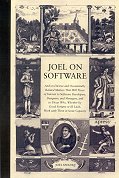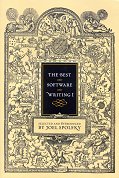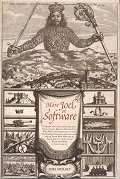Joel Spolsky has been writing his Joel on Software blog, about real software development, since before there were blogs. This book collects together, in dead tree form, some of the early online articles, with only a little extra material. It makes fascinating reading. He's worked for Microsoft, at other companies doing in-house software development, and now runs his own company, and all this diverse experience shines through.
There are two chapters I thought most important: The Joel Test of 12 steps to better code (how many are you doing?), and the Five Worlds of software development, and how different values and practices apply to each (or, there is no One Right Way). These, and lots of other fascinating snippets, insights, and wisdom, all written in a refreshing light and breezy style, make this a worthwhile read for anyone interested in the software industry.



